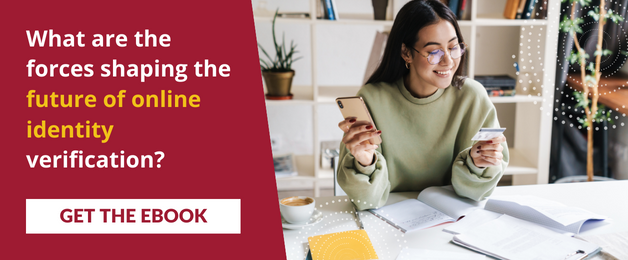Biometrics Products for Financial Applications

What are biometrics products used for?
Biometrics products, services and solutions are used by businesses to help determine if an individual is genuinely who they claim to be in order to help reduce identity takeover and themselves from potential fraud losses.
When used for identity verification to onboard new customers, apply for credit and open new accounts, biometrics products typically layer facial recognition with liveness detection and document verification and fraud analysis. These layers can help to ensure that the individual completing the application is real and the same person in the ID documents they are presenting and to verify that the individual's ID document is genuine and original.
Conventional methods of confirming a customer's identity, such as emailing in ID documents or visiting a branch to confirm your identity, present security risks to the customer, lack fraud protection for the business or are cumbersome and expensive. Biometrics solutions have enabled this process to occur remotely without compromising security or efficiency.
What should you look for in a biometrics solution?
There are a range of applications for biometrics products, services and solutions. In the best solutions, intuitive technology works behind the scenes, removing human intervention and improving accuracy while maintaining the highest data security and privacy levels. Here's what to look for when selecting a biometrics solution:
Biometrics facial matching
Facial biometrics algorithms scan the user's face and compare it against their photo ID document to help ensure the person applying for the credit or services is the same person in the ID document.
Look for a product that has been certified and audited by a reliable third party for low error rates - avoid solutions with an error rate higher than 1%. Also, consider how the solution avoids race or age bias when performing the match.
ID document capture
Ensure the biometrics solution you are considering captures live images of ID documents and doesn't allow photo uploads. Photo uploads have the potential for a fraudster to create or edit an image of anID document.
Best practice is to take a live photo of the ID document using your mobile phone in the same session as your live selfie to avoid digitally edited documents. Look for a solution that uses a mobile phone to capture the live images rather than a desktop/webcam. A mobile device will capture a high-resolution image compared to a webcam, allowing for better analysis and delivering a better user experience for the customer.
Document fraud analysis
This security layer analyses the ID document to assess whether it is a genuine ID document that has not been tampered with and is not a forgery. Look for a biometrics solution that does more than compare the ID document to the standard template. It should be engineered to identify a wide range of document tampering and reproduction methods, both common and sophisticated. These fraud attempts might include photocopies or reprinting, screen detection, photo tampering or replacement, photoshopping, tampering with the film, physical security features (e.g. holograms), and specific document attributes (e.g. font, typeface, alignment, colour).
Also, consider the level of experience the provider has with the document types you require and the ability for their machine learning technology to bring about continuous improvement.
Optical Character Recognition (OCR)
This AI-powered technology extracts the relevant data from the ID document, such as name, document numbers, address and date of birth. This feature enhances the customer experience and accuracy, avoiding manual entry and key-stroke errors. It also provides structured data to complete downstream actions such as auto-completing forms and data validation.
Look for a biometrics solution that allows the customer to confirm the structured data once extracted and includes a mechanism to enable the customer to consent for the data to be verified.
Liveness detection
Liveness is a crucial layer of biometric verification. It determines that the individual completing the verification is a real person and detects when a fraudster is holding up a photo of the real user, wearing a mask or using AI or deep fakes in place of a real selfie. Facial spoofing is the name given to the digital manipulation of images so a fraudster can pretend to be a legitimate user.
Some biometrics products use active liveness detection, which requires the user to respond to an instruction, such as smiling or turning their head. Others use passive liveness detection, which doesn't require movement. Look for a biometrics solution that combines both active and passive liveness to achieve a high level of accuracy and is certified to capture 100% of all presentation attacks.
Data verification
Data verification uses the information from the ID document to verify the individual's identity against external databases to determine if the documents are legitimate and not expired or cancelled. Databases can include the Australian Government's Document Verification Service (DVS), fraud registers, and Politically Exposed Persons (PEP) and sanctions watchlists.
Look for an biometrics solution that will automatically perform this action using a reliable ID verification source (e.g. IDMatrix), and where the data results are included in your overall verification scorecard result.
Why are biometric solutions important?
Growing identity fraud and increased regulatory compliance requirements have made it necessary for businesses to embrace more secure and reliable ways to protect against bad actors stealing people's identities. Document forgeries have become so sophisticated that fake ID documents can easily pass a human inspection.
Equally, fraudsters have become adept at bypassing digital identity verification systems that don't incorporate additional layers of security. Even when a verification method ticks the box for compliance, a match can still be identity fraud if the user completing the verification is not the same person in the identity documents.
The challenge for businesses is achieving the optimal balance between security and user experience. Drop-offs and application abandonment occurs when verification requirements are too onerous, slow and cumbersome, requiring customers to manually type in their ID data or jump through multiple screening hoops.
In today's digital world, where customers expect convenience without compromising security, biometrics products enable businesses to improve the customer experience and compete with their tech-savvy competitors.
The gold standard biometrics identity verification solutions use technological innovation and global best practices to combine verification and authentication elements into a single, seamless mobile workflow.
Equifax Biometrics is a leading biometrics identity verification solution and combines all these best practice elements and more into a single elegant mobile workflow. We offer TDIF accredited services under the Australian Government's Trusted Digital Identity Framework (TDIF) via our trusted partner IDVerse, an OCR Labs Company. The solution meets rigorous privacy protections, risk management, security and fraud controls. Our Australian-based customer support team complements our global leadership in data, analytics and technology.
To learn more about facial recognition and identity verification, get in touch with an Equifax Biometrics expert here, or download our short demo. You can also learn more on our Equifax Biometrics product page.

